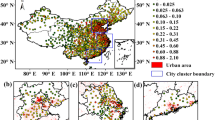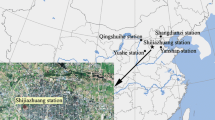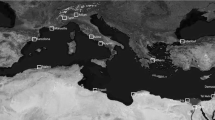Abstract
Based on homogenized land surface air temperature (SAT) data (derived from China Homogenized Historical Temperature (CHHT) 1.0), the warming trends over Northeast China are detected in this paper, and the impacts of urban heat islands (UHIs) evaluated. Results show that this region is undergoing rapid warming: the trends of annual mean minimum temperature (MMIT), mean temperature (MT), and mean maximum temperature (MMAT) are 0.40 C decade−1, 0.32 C decade−1, and 0.23 C decade−1, respectively. Regional average temperature series built with these networks including and excluding “typical urban stations” are compared for the periods of 1954–2005. Although impacts of UHIs on the absolute annual and seasonal temperature are identified, UHI contributions to the long-term trends are less than 10% of the regional total warming during the period. The large warming trend during the period is due to a regime shift in around 1988, which accounted for about 51% of the regional warming.







Similar content being viewed by others
References
Brohan P, Kennedy J, Harris I, Tett SFB, Jones PD (2006) Uncertainty estimates in regional and global observed temperature changes: a new dataset from 1850. J Geophys Res 111:D12106. doi:10.1029/2005JD006548
Easterling DR, Horton B, Jones PD et al (1997) Maximum and minimum temperature trends for the global. Science 227:364–367
Feng S, Hu Q, Qian W (2004) Quality control of daily meteorological data in China, 1951–2000: A new dataset. Int J Climatol 24:853–870
Gallo KP, Easterling DR, Peterson TC (1996) The influence of land use/land cover on climatological values of the diurnal temperature range. J Climate 9:2941–2944
Gallo KP, Timothy WO, Easterling DR et al (1999) Temperature trends of the U.S. historical climatology network based on satellite-designated land use/land cover. J Climate 12:1344–1348
Hansen JR, Lebedeff S (1987) Global trends of measured surface temperature. J Geophys Res 92(13):13345–13372
He J, Liu J, Zhuang D et al (2007) Assessing the effect of land use/land cover change on the change of urban heat island intensity. Theor Appl Climatol 90:217–226
Houghton JT, Ding Y, Griggs DJ et al (2001) Contribution of working group I to the third assessment report of the intergovernmental panel on climate change. In Climate Change 2001: The Scientific Basis, eds. University of Cambridge
Jones PD, Hulme M (1996) Calculating regional climatic time series for temperature and precipitation: methods and illustrations. Int J Climatol 16:361–377
Jones PD, Raper SCB, Bradley RS et al (1986a) Northern hemisphere surface air temperature variations: 1851–1984. J Appl Met 25:161–179
Jones PD, Raper SCB, Wigley TML (1986b) Southern hemisphere surface air temperature variations: 1851–1984. J Appl Met 25:1213–1230
Jones PD, Lister DH, Li Q (2008) Urbanization effects in large-scale temperature records, with an emphasis on China. J Geophys Res 113:D16122. doi:10.1029/2008/JD009916
Jones PD, Groisman PYA, Coughlan M, Plummer N, Wang W-C, Karl TR (1990) Assessment of urbanization effects in time series of surface air temperature over land. Nature 347:169–172
Kalnay E, Cai M (2003) Impact of urbanization and land-use change on climate. J Nature 423(6939):528–531
Karl TR, Diaz HF, Kukla G (1988) Urbanization: its detection and effect in the United States climate record. J Climate 1:1099–1123
Li Q (2006) The contribution of UHI effect to the China surface warming: Since 1954 and since 1979, 2006, Abstract of Western Pacific Geophysics Meeting (Invited presentation in WPGM2006)
Li Q, Zhang H, Liu X et al (2004) Urban heat island effect on annual mean temperature during the last 50 years in China. Theor Appl Climatol 79:165–174
Li Q, Zhang H, Chen J, Li W, Liu X, Jones PD (2009) A mainland China homogenized historical temperature dataset of 1951–2004. Bull Am Meteo Soci. doi:10.1175/2009BAMS2736.1
Ma L, Zhang T, Li Q, Frauenfeld OW, Qin D (2008) Evaluation of ERA-40, NCEP-1, and NCEP-2 Reanalysis Air Temperatures with Ground-based Measurements in China. J Geophys Res 113:D15115. doi:10.1029/2007JD009549
Parker DE (2004) Large-scale warming is not urban. Nature 432:290–290
Parker DE (2006) A demonstration that large-scale warming is not urban. J Climate 19:2882–2895
Peterson TC (2003) Assessment of urban versus rural in situ surface temperature in the contiguous United States: No difference found. J Climate 16:2941–2959
Peterson TC, Karl TR, Jamason PF, Knight R, Easterling DR (1998) First difference method: Maximum station density for the calculation of long-term global temperature change. J Geoghy Res 103:25967–25974
Ren G, Chu Z, Chen Z et al (2007) Implications of temporal change in urban heat island intensity observed at Beijing and Wuhan stations. Geophys Res Lett 34(5):L05711 (1–5)
Ren G, Zhou Y, Chu Z, Zhou J, Zhang A, Guo J, Liu X (2008) Urbanization effects on observed surface air temperature trends in North China. J Climate 21:1333–1348
Rodionov SN (2004) A sequential algorithm for testing climate regime shifts. Geophys Res Lett 31(5):L09204 (1–4)
Simmons AJ, Jones PD, da Costa Bechtold V, Beljaars ACM, Kållberg PW, Saarinen S, Uppala SM, Viterbo P, Wedi N (2004) Comparison of trends and low-frequency variability in CRU, ERA-40 and NCEP/NCAR analyses of surface air temperature. J Geophys Res 109:D24115. doi:10.1029/2004JD006306
Trenberth KE, Jones PD, Ambenje P et al (2007) Observations: surface and atmospheric climate change. Contribution of working group I to the fourth assessment report of the intergovernmental panel on climate change. In climate change 2007: The physical science basis, eds. University of Cambridge
Tu Q (1984) The trends and periodicity of temperature change in China during recent 100 years. J Nanjing Inst Meteorol 7:15–30 (in Chinese)
Vinnikov KY, Groisman PY, Lugina KM (1990) Empirical data on contemporary global climate changes (temperature and precipitation). J Climate 3:662–677
Wang S, Ye J, Gong D, Zhu J, Yao T (1998) Construction of mean annual temperature series for the last one hundred years in China. Q J Appl Meteorol 9:396–401 (in Chinese)
Wang T, Wu W, Xue X et al (2004) the special and temporal changes of the desertaztion land in North Chian during recent 50 years. Acta Geogr Sin 59:203–212
Wang X, JuLian L, Gaffen DJ (2001) Late-Twentieth-Century climatology and trends of surface humidity and temperature in China. J Climate 14:2833–2845
Yan Z, Li Z, Li Q, Jones PD (2009) Effects of site-change and urbanisation in the Beijing temperature series 1977–2006. Int J Climatol (in press)
Zhai P, Chao Q, Zou X (2004) Progress in China's climate change study in the 20th century. J Geograph Sci 21(z1):3–11
Zhang J, Dong W, Ye D et al (2003) New evidence for effects of land cover in China on summer climate. Chin Sci Bull 48:401–405
Zhou LM, Dickinson RE, Tian YH, Fang JY, Li QX, Kaufmann RK (2004) Evidence for a significant urbanization effect on climate in China. Proc Natl Acad Sci USA 101:9540–9544
Zhou S, Su J (1994) Urban climatology. Meteorological Press, Beijing, p 244
Acknowledgements
This paper has been supported by the National Natural Science Foundation of China (grant 40605021), National Key Technology R&D Program (2007BAC29B01-01) and the Ministry of Science and Technology of China through the based platforms special project of scientific data sharing system (grant 2005DKA31700-01). The corresponding author would like to thank David Parker for many constructive suggestions during the corresponding author's visit to the Met Office Hadley Centre. Phil Jones has been supported by the U.S. Department of Energy (grant DE-FG02-98ER62601).
Author information
Authors and Affiliations
Corresponding author
Appendix
Appendix
1.1 Methodologies of sequential regime shift detection method
Let x1, x2, ..., xi, be a time-series with new data arriving regularly. When a new observation arrives, a check is performed to determine if it represents a statistically significant deviation from the mean value of the current regime. If it does, that year is marked as a potential change point c, and subsequent observations are used to confirm or reject this hypothesis. The hypothesis is tested using the regime shift index (RSI), which is calculated for each c:
where m = 0,1…, l − 1 (i.e., number of years since the start of a new regime), l being the cut-off length of the regimes to be tested, and σ 1 is the average standard deviation for all 1-year intervals in the time series. RSI represents a cumulative sum of normalized deviations \( x_i^* \)) from the hypothetical mean level for the new regime (\( \overline {{x_{\text{new}}}} \)), for which the difference, diff, from the mean level for the current regime (\( \overline {{x_{\text{cur}}}} \)) is statistically significant according to a Student's t test:
where t is the value of the t distribution with 2 l − 2 degrees of freedom at the given probability level p. If, at any time from the start of the new regime, RSI becomes negative, the test fails and a zero value is assigned. If RSI remains positive throughout l − 1, then c is declared to be the time of a regime shift at the level ≤p. The search for the next regime shift starts with c + 1 to ensure that its timing is detected correctly even if the actual duration of the new regime is <l year.
In a previous version of the program, Rodionov (2004) used a running window of a fixed size equal to 2l (i.e. [c − l, c + l], centered at c). In this case, the average value for the current regime \( \overline {{x_{\text{cur}}}} \) is calculated for the period (c − l, c). If a transition from one regime to another is gradual, the program might not detect it because \( \overline {{x_{\text{cur}}}} \) is also changing as the window slides along the time axis, so the difference between the new arriving observations and \( \overline {{x_{\text{cur}}}} \) may not be statistically significant to become a potential change point and trigger the calculation of RSI. In the new version used here, \( \overline {{x_{\text{cur}}}} \) is calculated for the period from the previous regime shift to the point immediately before the current point in time. As a result, a stepwise function of regimes is produced in almost all cases, whereas the previous version of the program could detect abrupt regime shifts only. To improve the performance at the beginning of the time series, the testing for a regime shift starts not from x l + 1, as in the previous version, but from x 2. The average value \( \overline {{x_{\text{cur}}}} \) is still calculated for the entire initial period [1, l], but if a regime shift occurred prior to i = l, it is detected.
Rights and permissions
About this article
Cite this article
Li, Q., Li, W., Si, P. et al. Assessment of surface air warming in northeast China, with emphasis on the impacts of urbanization. Theor Appl Climatol 99, 469–478 (2010). https://doi.org/10.1007/s00704-009-0155-4
Received:
Accepted:
Published:
Issue Date:
DOI: https://doi.org/10.1007/s00704-009-0155-4




